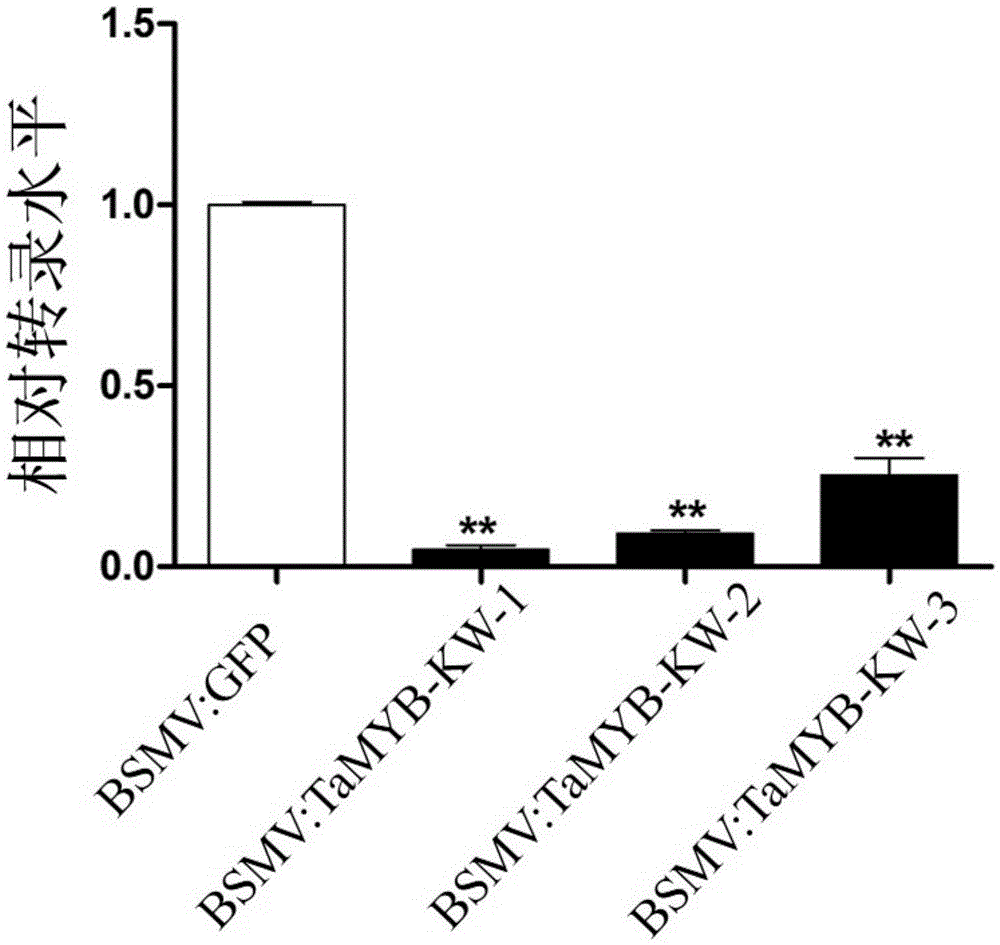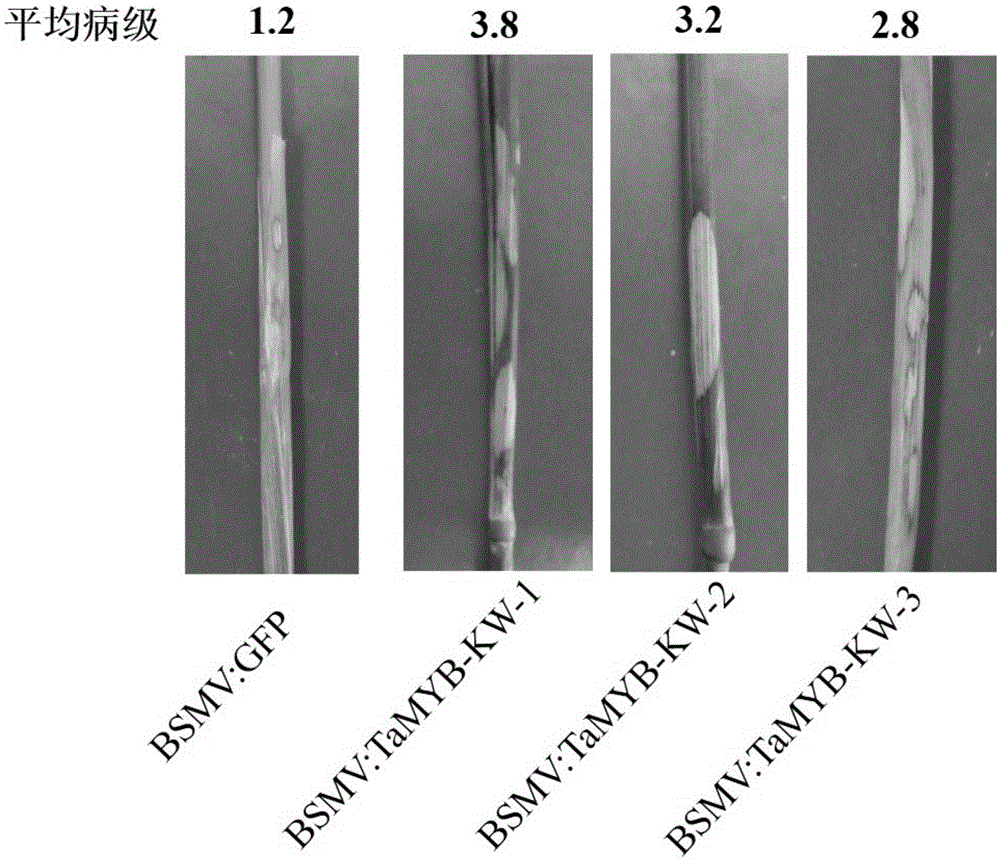Cultivating method for disease-resistant TaMYB-KW gene-transferred wheat, related biomaterials and application
A biomaterial and transgenic plant technology, applied in the cultivation of disease-resistant transgenic TaMYB-KW wheat and related biomaterials and application fields, can solve the problems of lack of wheat disease-resistant germplasm resources and slow research progress.
- Summary
- Abstract
- Description
- Claims
- Application Information
AI Technical Summary
Problems solved by technology
Method used
Image
Examples
Embodiment 1
[0090] Embodiment 1, the cloning of wheat disease resistance protein TaMYB-KW and its coding gene
[0091] The inventor of the present application isolated and cloned a wheat disease resistance protein from sheath blight resistant wheat CI12633, and named it TaMYB-KW. The specific cloning method of TaMYB-KW gene is as follows:
[0092] Take the leaves of wheat CI12633 seedlings inoculated with Rhizoctonia solani, treat them with liquid nitrogen, and extract the total RNA of the leaves according to the instructions of the Invitrogen TRIZOL Reagent total RNA extraction reagent. According to the procedures of Invitrogen's first-strand cDNA synthesis kit, the extracted RNA samples were reverse-transcribed to synthesize first-strand cDNA, which was used as a template for gene cloning.
[0093] In order to obtain the full-length cDNA sequence of TaMYB-KW gene, two pairs of primers were used to amplify by RACE and nested PCR. Using the primer pair TaMYB-KWA-U1 (5'-GCAGCATTTACCTTCGG...
Embodiment 2
[0094] Embodiment 2, TaMYB-KW gene is subjected to the induced expression analysis of wheat sheath blight pathogen
[0095] In order to study whether the expression level of TaMYB-KW gene is related to the resistance of wheat sheath blight, Q-RT-PCR was used to analyze the expression of TaMYB-KW gene in the sheath blight resistant wheat CI12633 inoculated with Rhizoctonia graminearum for 4 days and 10 days. Express the situation.
[0096] Inoculate between the leaf sheaths and stems of wheat CI12633 tillering stage seedlings with wheat sheath blight pathogenic bacteria-Rhizoctonia graminearum (Rhizoctoniacerealis) R0301 mycelia toothpicks and wheat grains; take wheat stems 4 days and 21 days after inoculation, liquid nitrogen Store in -80°C ultra-low temperature freezer after quick freezing.
[0097] Total RNA (about 5 μg total RNA per sample) was extracted from each wheat stem, and reverse-transcribed into cDNA according to the procedure of Invitrogen's first-strand cDNA syn...
Embodiment 3
[0103] Example 3, Acquisition of TaMYB-KW Silenced Wheat and Identification of Disease Resistance
[0104] 1. Construction of recombinant expression vector
[0105] 1. Inoculate wheat CI12633 stems and leaf sheaths with Rhizoctonia graminearum (Rhizoctoniacerealis) R0301, extract RNA after 4 days, reverse transcribe into cDNA; use cDNA as template, use TaMYB-KW-VIGS-F and TaMYB-KW-VIGS- The primer pair composed of R was subjected to PCR amplification to obtain a PCR amplification product (a TaMYB-KW fragment carrying an NheI site).
[0106] TaMYB-KW-VIGS-F:5'-ACA GCTAGC TCGTCCGCCACCGATTACT-3' (underlined as NheI enzyme recognition site);
[0107] TaMYB-KW-VIGS-R:5'-GGC GCTAGC CTCTGCCTAAATCTGAGACAAAC-3' (underlined as NheI enzyme recognition site).
[0108] PCR reaction program: first 94°C pre-denaturation for 3 minutes; then 94°C for 30s, 56°C for 30s, 72°C for 1min, 15 cycles; 94°C for 30s, 60°C for 30s, 72°C for 1min, 20 cycles; finally, 72°C for 10 minutes end.
[0...
PUM
 Login to View More
Login to View More Abstract
Description
Claims
Application Information
 Login to View More
Login to View More - R&D
- Intellectual Property
- Life Sciences
- Materials
- Tech Scout
- Unparalleled Data Quality
- Higher Quality Content
- 60% Fewer Hallucinations
Browse by: Latest US Patents, China's latest patents, Technical Efficacy Thesaurus, Application Domain, Technology Topic, Popular Technical Reports.
© 2025 PatSnap. All rights reserved.Legal|Privacy policy|Modern Slavery Act Transparency Statement|Sitemap|About US| Contact US: help@patsnap.com



